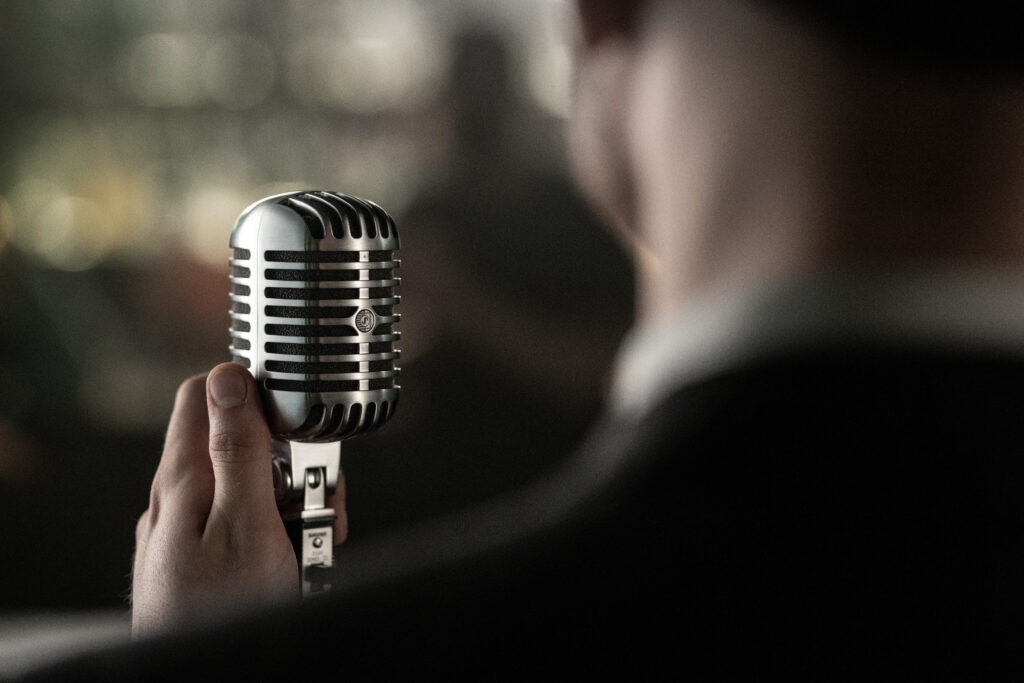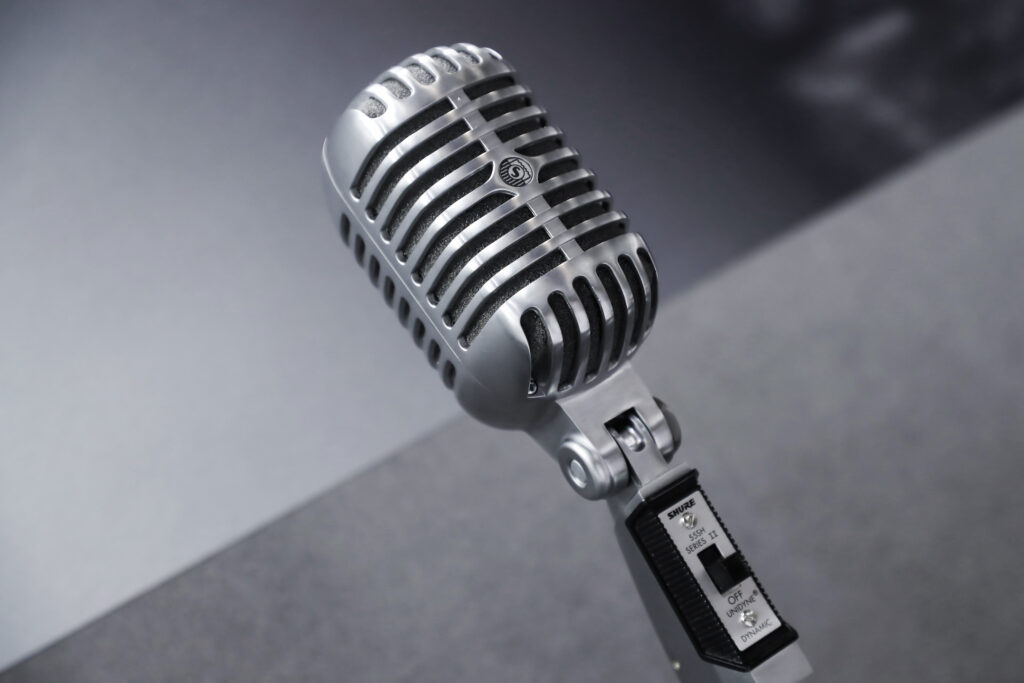
The Shure 55SH Series II is an iconic vocal microphone that meets the demands of modern vocalists whilst retaining an endearing vintage charm.
Shure 55 series microphones, including the Shure 55SH, have been a symbol of quality and reliability for decades. This iconic microphone family, often referred to as the “Elvis Microphone,” has evolved and developed as technology has progressed.
It’s a beloved microphone with a rich lineage. Music legends such as Elvis Presley, Frank Sinatra, Billie Holiday and Johnny Cash helped make it a legend. But what exactly makes the Shure 55SH microphone an icon? To answer that question, we need to take a closer look at its history.
From Rockstars To Politicians
The Shure 55SH Series II is part of the Unidyne Series of microphones, which have been around since 1939. The Unidyne Series quickly became a mainstay in the world of professional audio. Celebrities, entertainers, and politicians alike relied on them to convey their voices.
They survived war-time service and were familiar fixtures at critical moments in history. Scores of photographs, films, and videos show this microphone series in the company of kings, queens, presidents, and generals.
They stood in front of Frank Sinatra and Ella Fitzgerald during the Big Band era. Elvis embraced them in performance and on a first-class stamp issued in 1994 by the United States Postal Service.
Countless rock stars, past and present, have chosen the 55 Unidyne Series. Today, decades after their first appearance, Unidyne Microphones are as popular and sought after as ever.

The 55 Series
The original Unidyne became the first in the 55 Series. Using the proprietary Shure “Uniphase” acoustical system, the Unidyne was marketed for broadcast, public address, recording, and two-way radio. It was sold in three configurations, each with a different impedance option.
The Model 55A was low impedance for broadcast applications. The Model 55B was medium impedance for public address and recording applications. Finally, the Model 55C was high impedance for two-way radio applications.
The list price in 1939 for the 55A was $42.50 (U.S.), while models 55B and 55C cost $45. The catalogue copy proclaimed that “you get the sound you want, as you want it.” It was, “the first high-quality, low-cost moving-coil dynamic microphone with true cardioid unidirectional characteristics.” The Unidyne reduced the problems of feedback, background noise, and reverberation – a true game changer.
Unidyne – The First Choice
Shure literature from back in the day proudly proclaimed the advantages of cardioid unidirectional microphones. They said these mics gave “wide-angle coverage with excellent high-quality response at the front, yet are dead at the rear.” Even today, a Unidyne Microphone is often the first choice in difficult acoustical situations.
Shure engineer Benjamin Bauer was the driving force behind the development of the first Unidyne. Bauer began developing the microphone in early 1937. In undertaking the project, his goal was to create a unidirectional microphone using a single dynamic element.
Before the Unidyne, the most common way of creating a microphone with a cardioid response was to use an omnidirectional (non-directional) element. This was combined with a bidirectional (“figure-eight” pickup pattern) element in a single housing.
When the outputs from both cartridges were electronically combined, the result was a cardioid pickup pattern. Other directional patterns could be obtained by altering the relative balance of the two cartridges with a multi-position switch.

Early Challenges
These early dual-element unidirectional microphones had drawbacks. Their size tended to be large and bulky, and consistent performance was hard to maintain.
The omnidirectional and bidirectional elements did not have the same frequency responses and occupied different locations within the housing. As a result, the frequency response and polar pattern were irregular and difficult to control. This was far from ideal.
Using Physics
Ben Bauer recognized that the best way to address these difficulties was to use a single element. He began by examining the underlying physics.
Bauer realized that exposing both sides – the front and back – of a microphone element to sound would result in a bidirectional microphone. He also understood that exposing a single element to sound only on its front side would produce an omnidirectional pattern.
With those two concepts in mind, he realized he could achieve a response between an omnidirectional and a bidirectional one by partially blocking the back side of a microphone element. In theory, this would result in a cardioid (heart-shaped) pattern.
Bauer’s research led to the development of the Uniphase acoustical system. Shure would use this in their first single-element microphone, the Uniplex, and later in the Unidyne.
The First Unidirectional Dynamic Mic
Bauer configured the Unidyne with an acoustical network of front and rear openings that allowed sound waves to reach both sides of the microphone’s diaphragm. The sound waves reaching the diaphragm from the rear had a longer path.
They then passed through openings that produced a time delay between the sound entering from the rear and sound waves striking the front of the diaphragm.
By varying the acoustical resistance in the rear openings, Bauer was able to achieve a cardioid, a supercardioid, or a hypercardioid pattern using a single element. As a result, the first unidirectional dynamic microphone became a reality.

A New Standard of Audio
An instant success, the original Unidyne set a new standard of high-quality audio combined rejection of unwanted sounds. True to Bauer’s design, the directional response was more predictable and better behaved than its predecessors.
It offered a new ability to control feedback and reduce ambient noise pickup. This mic changed the game, gaining popularity with singers, entertainers, and public speakers due to its smaller size compared to other mics available at the time.
With the Unidyne’s success, it became a mainstay in the music industry and remained popular among musicians even as new microphone technologies emerged.
In the 1960s, the Beatles famously used the Unidyne for their landmark performances. It eventually became synonymous with the sound of rock and roll.
The Unidyne became popular not just in music, but also in television and film production, with iconic movies such as Goodfellas and Apollo 13, and TV shows like The Tonight Show Starring Johnny Carson and Saturday Night Live, featuring the microphone prominently.
Evolution of the Unidyne Series
Throughout the years, the Unidyne series saw several changes and improvements. For example, the broadcast version of the microphone was updated with an improved vibrational isolation mount, a radio station call letter plate, and a multi-impedance selector switch.
In 1951, Shure introduced the “Small Unidyne,” featuring the Unidyne II cartridge, which offered improved magnet materials, diaphragm suspension, and cartridge isolation. The Small Unidyne microphones were lighter and more compact than their predecessors, making them even more popular.
Over the years, other modifications to the 55S model included a change to the support base in 1961, the elimination of the multi-impedance selector in 1978, and the use of open cell foam as the internal windscreen material, replacing the original open weave cloth.

The 55 Unidyne Series – Iconic Style & Sound
The 55 Unidyne Series microphones have become cultural icons, and their enduring popularity can be attributed to their excellent performance, distinctive design, and association with numerous famous figures and historical events.
The Unidyne has been used by countless celebrities, politicians, and entertainers, from Rudy Vallee and Elvis Presley to President Truman and Martin Luther King Jr. It has also been featured on postage stamps, television shows, movies, and countless websites.
As Shure Associate Tim Vear explains, the Unidyne series has a “coolness quotient” that adds to its iconic status, similar to a ’57 T-bird, a Stratocaster guitar, or a James Dean movie.
Furthermore, the microphones’ performance and quality adhere to the Shure tradition of excellence, ensuring that they are reliable and effective audio tools as well as symbols of pop culture.
The list of major entertainers who have used or still use Unidynes includes Marlene Dietrich, Dean Martin, Jerry Lewis, Tony Bennett, Buddy Guy, Tom Petty, LeAnn Rimes, Metallica, and Mariah Carey, among many others.
As Shure approaches its 100th anniversary in 2025, the enduring popularity and iconic status of the 55 Unidyne Series is a testament to its timeless design and performance.

The 55SH Series II – Classic & Contemporary
Today, Shure’s 55SH Series II is the latest iteration of the classic Unidyne design and builds upon the original Model 55.
It features a frequency response tailored for speech, vocals, and instrument recording, making it a versatile option for a wide range of audio applications. The microphone’s rugged build quality and classic design have made it a go-to choice for live performances, podcasts, and studio recordings.
Stylish & Durable
The Shure 55SH Series II microphone features a distinctive die-cast metal housing with a satin chrome-plated finish, giving it a classic and elegant appearance. The microphone’s vintage design is not only visually appealing but also functional, as it provides excellent durability and resistance to wear and tear.
Sing With Confidence
The 55SH Series II utilizes a dynamic, cardioid element that offers a frequency response tailored for vocals and speech, ensuring clear and natural sound reproduction. Its cardioid polar pattern provides excellent off-axis rejection, minimizing feedback and background noise, making it an ideal choice for live performances and public speaking events.
Reduced Handling Noise
Another notable feature of the 55SH Series II microphone is its built-in shock mount system. This design helps to isolate the microphone element from mechanical vibrations, reducing handling noise and ensuring clear audio reproduction even in challenging environments.
Adapts With Ease
Plus, the 55SH Series II microphone comes equipped with a swivel mount that allows for easy positioning and angle adjustments. This makes the 55SH Series II easily adaptable to various stage setups and performance situations.
Vintage Design, Modern Performance
In addition to its modern enhancements, the Shure 55SH Series II retains the iconic design and high-quality audio performance that has made the Unidyne a beloved microphone for over 80 years.
The microphone’s influence can be seen in countless performances, recordings, and cultural touchstones. This mic has cemented its place as one of the most important pieces of audio technology ever created.
The Shure 55SH Series II microphone is a testament to the enduring legacy of the Unidyne design. From its humble beginnings in 1939, the Unidyne has become an iconic symbol of high-quality audio and timeless design.
Its impact on the music industry, television, and film cannot be overstated. Today, the 55SH continues to be a popular choice among musicians and performers.
Whilst technology will continue to evolve, the timeless charm of the 55SH will continue to make it a first-choice mic for generations to come.